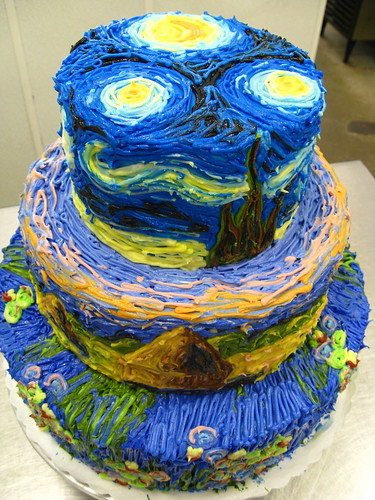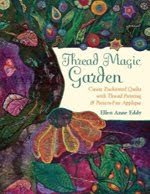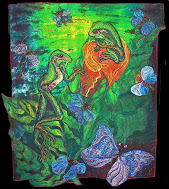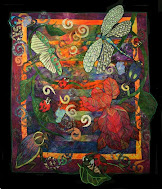Tuesday, May 31, 2011
Designing Ways: East Meets West
It's almost impossible to talk about our art without talking about the art that comes before us. Before we talk about design, it's worth saying that there are many different design aesthetics. It's not that a design is good or bad necessarily. It's designed to be part of the statement. The notions that fuel our art choices are a statement loud and clear past subject matter and past our technical handling of fabric and thread.
As quilters, a lot of us have backed into art by accident. We started with squares and one day found ourselves with an odd quilt that somehow was an art quilt. Maybe it had too much orange in it or you found yourself like me, embroidering frogs and bugs into the borders.There's a tender soft spot in most quilter's artistic persona. The part that said that you should have gone to art school or studied water color. So our first designs spring out of a personal view. Later, as we become more facile, we realize that the choices in design are a huge statement all their own.
My first artistic love was the impressionists. I grew up near Chicago, and there was a pilgrimage every year to the Art Institute. I strolled through the halls looking for paintings like old friends. Since they were my first real introduction to art, they felt bland to me. Safe. Something soft and soothing out of my childhood.You know it's become mainstream when you see it on a birthday cake. This astonishing cake is by Megpi, a pastry chef in Silver Lake. California. You can see her work if you follow the link to Flickr.
impressionist cake, a photo by megpi on Flickr
Since you can buy Van Gogh's work on umbrellas and coffee cups, it's easy to miss the point that he was a raving revolutionary in his time. His work nauseated the current critics, got him hospitalized, was refused for all the important salon shows, and the subject of ridicule in the press. Time and familiarity have made him a lionized artist, but that was not who he was when he began.
I was immediately in love when I discovered Japanese prints. It was a while before I realized why. The Impressionists took much of their new artistic vision from the prints out of Japan. The first prints that came out of Japan hugely influenced them as beginning artists.
In contrast, this is a painting called Nocturne from around 1825 by Turner. Turner would have represented the design aesthetics from the early 19th century, that Van Gogh and the other impressionists and Post Expressionists blew out of the water.
Early 19th Century Western art was about permanence. It honored stability. It was a world of people in their proper places, forever and ever. It used Greek and Roman scenes and portraits of nobility as an way of saying we had an eternal understanding of a world that stayed the same.
Japanese art was about the moment. It moved. It created a path for the eye to follow. It went off the page. The impressionists saw it, fell in love with the concept and incorporated it into the designing of their art. And changed us all.
The decisions behind design are the most telling. Without a word they say so much about what we create, what we find important, and what we value. The way we structure our art is at least half the story we tell.
Designing Ways: East Meets West
It's almost impossible to talk about our art without talking about the art that comes before us. Before we talk about design, it's worth saying that there are many different design aesthetics. It's not that a design is good or bad necessarily. It's designed to be part of the statement. The notions that fuel our art choices are a statement loud and clear past subject matter and past our technical handling of fabric and thread.
As quilters, a lot of us have backed into art by accident. We started with squares and one day found ourselves with an odd quilt that somehow was an art quilt. Maybe it had too much orange in it or you found yourself like me, embroidering frogs and bugs into the borders.There's a tender soft spot in most quilter's artistic persona. The part that said that you should have gone to art school or studied water color. So our first designs spring out of a personal view. Later, as we become more facile, we realize that the choices in design are a huge statement all their own.
My first artistic love was the impressionists. I grew up near Chicago, and there was a pilgrimage every year to the Art Institute. I strolled through the halls looking for paintings like old friends. Since they were my first real introduction to art, they felt bland to me. Safe. Something soft and soothing out of my childhood.You know it's become mainstream when you see it on a birthday cake. This astonishing cake is by Megpi, a pastry chef in Silver Lake. California. You can see her work if you follow the link to Flickr.
impressionist cake, a photo by megpi on Flickr
Since you can buy Van Gogh's work on umbrellas and coffee cups, it's easy to miss the point that he was a raving revolutionary in his time. His work nauseated the current critics, got him hospitalized, was refused for all the important salon shows, and the subject of ridicule in the press. Time and familiarity have made him a lionized artist, but that was not who he was when he began.
I was immediately in love when I discovered Japanese prints. It was a while before I realized why. The Impressionists took much of their new artistic vision from the prints out of Japan. The first prints that came out of Japan hugely influenced them as beginning artists.
In contrast, this is a painting called Nocturne from around 1825 by Turner. Turner would have represented the design aesthetics from the early 19th century, that Van Gogh and the other impressionists and Post Expressionists blew out of the water.
Early 19th Century Western art was about permanence. It honored stability. It was a world of people in their proper places, forever and ever. It used Greek and Roman scenes and portraits of nobility as an way of saying we had an eternal understanding of a world that stayed the same.
Japanese art was about the moment. It moved. It created a path for the eye to follow. It went off the page. The impressionists saw it, fell in love with the concept and incorporated it into the designing of their art. And changed us all.
The decisions behind design are the most telling. Without a word they say so much about what we create, what we find important, and what we value. The way we structure our art is at least half the story we tell.
Monday, May 30, 2011
Designing Ways: An Exploration of Design in Fiber Art
http://youtu.be/eNAcJ9o4XP0
Just recently I've been looking at the Spoonflower website. At Spoonflower you can design your own fabric.
That sounded simple. You add cool elements from your quilts on a neat background. How hard can it be? How cool can it get?
Well I don't think it get's cooler, but it's not as easy as it looks. I'm not ready for prime time yet but it's reminded me how important design is, and how it changes when we have different things we want out of our designs. So I'm going to take some time to explore design myself and to talk about that in some posts.
So often when we create we get all caught up in what we're creating. A flower, a frog, a bug, a picture. But design is the hidden framework under all of that. There are different aesthetics to design, different theories, different approaches. So when we talk about good design, we need to ask the question, "For what purpose."Designs that repeat are a whole different set of considerations from designs that don't have to. I'd like to look at design over a series of posts, from the point of view of pathway, rhythm, framing, and balance. Next time, East Meets West.
Designing Ways: An Exploration of Design in Fiber Art
http://youtu.be/eNAcJ9o4XP0
Just recently I've been looking at the Spoonflower website. At Spoonflower you can design your own fabric.
That sounded simple. You add cool elements from your quilts on a neat background. How hard can it be? How cool can it get?
Well I don't think it get's cooler, but it's not as easy as it looks. I'm not ready for prime time yet but it's reminded me how important design is, and how it changes when we have different things we want out of our designs. So I'm going to take some time to explore design myself and to talk about that in some posts.
So often when we create we get all caught up in what we're creating. A flower, a frog, a bug, a picture. But design is the hidden framework under all of that. There are different aesthetics to design, different theories, different approaches. So when we talk about good design, we need to ask the question, "For what purpose."Designs that repeat are a whole different set of considerations from designs that don't have to. I'd like to look at design over a series of posts, from the point of view of pathway, rhythm, framing, and balance. Next time, East Meets West.
Saturday, May 28, 2011
Musings: Art Outside the Box: The Green Eyed Monster and the Time Machine
Dancing in the Light
National Quilt Museum
Opening night, April 24th
Paducah, KY 2011
I got to go to Paducah to see the unveiling of my quilt. They bought Dancing in the Light, last year for their permanent collection. The opening was its first viewing there.
I wish I could say that I've had so many experiences like that that it felt normal or natural. I felt like Cinderella, thank God without the shoes. I arrived from my flight in Chicago, 15 minutes before the opening. I threw on my dress and ran ( as well as any lady my size with my knees can) to the ball. I met people who loved my quilt. I met people I'd loved forever for their work. I went from throwing- up-scared to simply sitting in a room with fellow artists I love.
I think any artist who's committed themselves to showing and to selling their work hits a point where it matters desperately what other people think.We all say we don't. It's whistling in the dark, as far as I can tell. It has to do with paying your mortgage at some point. But before that, you commit to your art it such a way that it has to pay you back in terms of some response. Those who are supported externally have a leg up on this, but they also lack some of the edge artistically.We're all waiting for the response. We do our artistic best and put it up the flag pole to see who salutes.
When I began doing art quilts in the late 1970's, there was an explosion of excellent people fighting to be seen. That's still ongoing. In fact it's so much harder to be recognized or for that point, remembered. We create, we show, we publish, we teach, and in that river of activity, we wait for the response.
In those early days, I remember the agony of not getting in. This show. That book. This opportunity. That also hasn't changed. There are only so many slots and there are many more pegs. It's a real danger sitting with a friend who's just gotten into Quilt National when you haven't. Your happy for her. Right? Right? Well, yes but. And the but is sour and has a long after-burn.
I realized at a certain point I was using these moments of win or lose, inclusion and exclusion to define who I am. Shallow as that is, it's hard not to. The green eyed monster affects all of us, no matter what color our eyes are.
Of course, outside the quilt world, who cares? The quilt world is a very tiny pond. I can't imagine anyone writing on my tombstone, " She finally got into Quilt National when she was 89." Of course they also won't write, "she had an immaculate house", or "she was always a size 3 jeans". I hope they say I did a good job continuing my art and of loving the people in front of me.
Time is a slow moving machine. But it does move. I've come to be grateful for the fact that it moves slowly. Attitude adjustment takes a long time sometimes. Somewhere after I'd written Thread Magic, I realized that I would have honors all my own. And that no one should collect them all. The green eyed monster seems to need the time machine to tame it into a glint, rather than a Gordon's stare. Perhaps what truly tames it is enough sense of who we are that we no longer are so hungry for definition. Or so willing to take it from external sources.
I sent in my IQA offering this week, with the green eyed monster locked safely down by the laundry machines in the basement. I don't always get in. I don't always get anything. But I have had mine. And so may we all.
Monday, May 23, 2011
Musing: Art outside the Box:The Call of the Less Wild than It Was
Every year I find myself drawn into the veggie garden. This little plot of land was part of my parking lot until I begged my godson Tom to dump 500 pounds of Sam's Choice
( and I do not mean potatoes) on it. This year, Lauren Strach and my neighbor Liam Oberlander offered me special help that made my garden much more organized, green and growing. Every year it provides enough lettuce, spinach, squash, peas and beans to feed me and every raccoon and bunny in Porter. We even manage to feed a neighbor or two. My crop of Japanese Beetles each year is magnificent.
Of course it's awfully hard to get out of the veggie garden and into the studio. Here is Bedelia Birdy Buttercup, greyhound in charge, trying to herd me out of the garden. She's not having much luck this year.
Ah well. She's not having much luck with the bunny either. Which is why I finally quilted the bunny in.
Sometimes your art is your life, that great river of creativity, clutter and projects. Then suddenly your life is the art of the moment, the placing of pots of plants or the need to find clean forks. It all gets unbalanced if it's simply one or the other. So as I sit in the veggie garden, watching the plants grow and hearing the happy munching of bunnies I know I"ll find my way back to the studio, but probably after lunch. And aren't I glad I planted all that lettuce?
Blossom in the Moonlight is one of three quilts on special sale on my site at http://www.ellenanneeddy.com/gallery.php. Can you find the other two? They're part of the river of art that goes on, once I get myself out of the art of my life.
( and I do not mean potatoes) on it. This year, Lauren Strach and my neighbor Liam Oberlander offered me special help that made my garden much more organized, green and growing. Every year it provides enough lettuce, spinach, squash, peas and beans to feed me and every raccoon and bunny in Porter. We even manage to feed a neighbor or two. My crop of Japanese Beetles each year is magnificent.
Of course it's awfully hard to get out of the veggie garden and into the studio. Here is Bedelia Birdy Buttercup, greyhound in charge, trying to herd me out of the garden. She's not having much luck this year.
Ah well. She's not having much luck with the bunny either. Which is why I finally quilted the bunny in.
Sometimes your art is your life, that great river of creativity, clutter and projects. Then suddenly your life is the art of the moment, the placing of pots of plants or the need to find clean forks. It all gets unbalanced if it's simply one or the other. So as I sit in the veggie garden, watching the plants grow and hearing the happy munching of bunnies I know I"ll find my way back to the studio, but probably after lunch. And aren't I glad I planted all that lettuce?
Blossom in the Moonlight is one of three quilts on special sale on my site at http://www.ellenanneeddy.com/gallery.php. Can you find the other two? They're part of the river of art that goes on, once I get myself out of the art of my life.
Wednesday, May 11, 2011
Fare well, Jean. And Thanks!
March 3, 2011 10:25 PM
Jean Ray Laury, 1928-2011
By Donald Munro |
Some sad news: We've lost Jean Ray Laury, Fresno's most beloved fiber artist. She died Wednesday after a long illness. From the obituary in Friday's paper:
Her most recent local project was an installation at the new headquarters of the San Joaquin River Parkway and Conservation Trust: five 9-foot banners that depict, in alluring colors, the array of plants, wildlife and other inhabitants of the river region. The project took two and a half years.
"I can't imagine any commission that could be more fun or more rewarding than this one," she told The Bee.
A graduate of Stanford University, Mrs. Laury developed an international reputation in the world of quilting and fiber arts, and traveled as a guest lecturer, including to Australia, Belgium, France, Norway and South Africa.
In 1999, her work was included in a Houston installation titled "America's 100 Best Quilts of the 20th Century.I'll be putting together an appreciation of Laury in the days to come, so if you have any thoughts on her artistic contributions or personal memories, feel free to share.
Several weeks ago when I was on facebook, I found Jean Ray Laury had died.
But it was there. What I do remember is seeing her quilts. Advice from Your Mother. Cowgirls. Political statements. They represented a huge change in the art quilt world. They centered around her printmaking skills and wacky sense of humor.They were strictly about women's work, ideas, lives fears and hopes. They were an education. I was at a conference several years ago with her and had the time to see her lecture. What I found was that I did know mountains of her work. Year after year, piece after piece, this quiet woman with a loud artistic voice made an astonishing statement about art, femininity, and self expression. Her work had lifted me to a level where I was brave enough to begin my own.
So many of us as quilters have a trick, a tool, a viewpoint of our own that makes us unique.Perhaps that was the beginning of the movement from quilt to art. I think Jean may have been part of the first of that. Her prints, so unlike quilts, but clearly quilted showed us that path. Now she shines on.
Do we have quilting saints? I hope we do. People larger than life, full of a path and vision that changes us all? I think we do. Saints are legends, not necessarily holy, so much as they are wholly what they are. Their lives illuminate ours. Their clarity clears away our clutter and confusion. Do they watch us to see what we do in their wake? God knows, we learned from watching them. I think she's a grand Saint Jean, of the quilt.
Fare well, Jean. And thanks!
Subscribe to:
Posts (Atom)
Ellen Anne Eddy's Flowers on Youtube.com
Labels
lunatic fringe
(22)
design
(18)
life as an artist
(18)
lifestyle
(18)
story telling
(11)
art quilting
(8)
fiber art
(8)
art quilters
(7)
books
(6)
color
(6)
free motion
(6)
gardening
(5)
Thread Magic Garden
(4)
embroidery
(4)
quilters
(4)
quilting
(4)
C and T Publishing
(3)
craft
(3)
flowers
(3)
Christmas
(2)
What problem?
(2)
archetypes
(2)
beads
(2)
bias
(2)
bobbin work
(2)
classes
(2)
filling the grid
(2)
sewing
(2)
threads
(2)
zigzag stitch
(2)
Wizard of Oz
(1)
choir
(1)
knitting
(1)
machine stitching
(1)
movies
(1)
seasons
(1)
youtube
(1)
Like us on Facebook
Quiltposium, Fall2011

Ellen's New Article, Dance of Design
Essential Embroidery Stitches: Free Hand and Machine Embroidery Designs and Techniques.
The Butterfly Effect

Blog Archive
-
▼
2011
(64)
-
▼
May
(7)
- Designing Ways: East Meets West
- Designing Ways: East Meets West
- Designing Ways: An Exploration of Design in Fiber Art
- Designing Ways: An Exploration of Design in Fiber Art
- Musings: Art Outside the Box: The Green Eyed Monst...
- Musing: Art outside the Box:The Call of the Less ...
- Fare well, Jean. And Thanks!
-
▼
May
(7)
My Blog List
-
4 days ago
-
1 week ago
-
1 month ago
-
4 months ago
-
6 months ago
-
8 months ago
-
3 years ago
-
3 years ago
-
3 years ago
-
4 years ago
-
5 years ago
-
5 years ago
-
6 years ago
-
7 years ago
-
7 years ago
-
7 years ago
-
7 years ago
-
8 years ago
-
9 years ago
-
9 years ago
-
9 years ago
-
9 years ago
-
10 years ago
-
10 years ago
-
10 years ago
-
10 years ago
-
11 years ago
-
11 years ago
-
11 years ago
-
11 years ago
-
11 years ago
-
11 years ago
-
11 years ago
-
11 years ago
-
12 years ago
-
-
-

Facebook Badge
Labels
archetypes
(2)
art quilters
(7)
art quilting
(8)
beads
(2)
bias
(2)
bobbin work
(2)
books
(6)
C and T Publishing
(3)
choir
(1)
Christmas
(2)
classes
(2)
color
(6)
craft
(3)
design
(18)
embroidery
(4)
fiber art
(8)
filling the grid
(2)
flowers
(3)
free motion
(6)
gardening
(5)
knitting
(1)
life as an artist
(18)
lifestyle
(18)
lunatic fringe
(22)
machine stitching
(1)
movies
(1)
quilters
(4)
quilting
(4)
seasons
(1)
sewing
(2)
story telling
(11)
Thread Magic Garden
(4)
threads
(2)
What problem?
(2)
Wizard of Oz
(1)
youtube
(1)
zigzag stitch
(2)





















